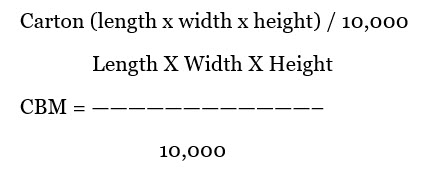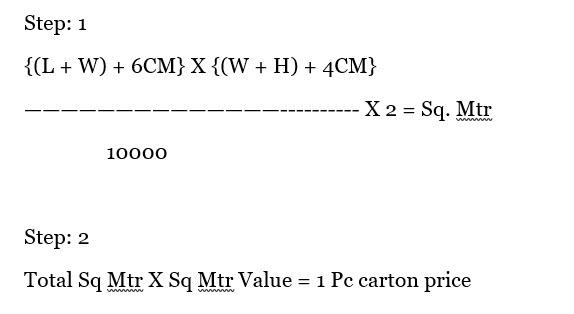Merchandising is a very tough profession that you can’t imagine. To provide the best performance in their profession merchandiser has to have keen knowledge on mathematics. It will help them to escalate in their professional life.
Today I will try to compile some mathematical calculations which may help you to continue Merchandising daily activities. Please find the following formulas for your reference.
CBM: CBM means cubic meter. CBM of 1 carton box can be determined in the following ways.

Total CBM = 1 Carton CBM X Total Carton
There are 3 types of container you may found for goods exportation.
(1) 20 feet Normal Container to hold 26-29 CBM goods.
(2) 40 feet Normal Container to hold 54-56 CBM goods.
(3) 40 feet High Container to hold 74-8 CBM goods.
Containers are usually rented in two ways
(1) FCL: Full Container Load
(2) LCL: Light Container Load
We can follow below formula to find out poly bag costing.
Suppose,
A LDPE poly bag having 28” length, 3” flap, 14” width, 140-gauge thickness with self-adhesive facility and if the cost of polymer is $.50 per lb. Polymer is the main ingredients to produce poly bag. Let’s find out the cost of 1 PC poly bag.
So, the weight of material = (28 + 3 x 14 x 140) / 3300
= 60760 / 3300
= 18.412 kg / 1000 pieces
Cost of Material = 18.412 kg x $.50 per lb
= 18.41 x $1.1 Kg (as we know 1 kg=2.20 lb)
= $20.253 / 1000 pieces
= $0.020 (cost of 1pc poly bag)
Cost of Adhesive tape= 28” x $.002
= $.056
So, final cost of 1-piece poly bag will be = ($0.020+$.056)
= $0.076
Many Senior merchandisers have been doing merchandising for 5/6 years but regret to say that they can’t do Carton Consumption & Cost properly. They have to depend on Supplier Consumption & Costing. This shows that the supplier is taking money as he wishes. You don’t even understand yourself. Please download a ready-made formula to get carton box costing quickly.
Carton’s square meters and volume

Sewing Thread: As a merchandiser, you have to count sewing thread frequently to find out product costing. Please download a ready made formula to get sewing thread costing quickly. I have attached another formula to get embroidery costing quickly. Please download it from the attached link.

Now you have to keep in mind that the color of your order is different according to the number of colors, you will find out by adding the total. I ask them to come out differently according to the color. Because we use different sewing threads according to the color, if we take it out at once, we can see that it is less than 1/2 due to the point.
Talking a lot about Primary Consumption. I thought I would give Polo Shirt Consumption but suddenly I thought let’s discuss regarding Marker Consumption. Marker Consumption always gives Consumption of 20 Pieces Garments. This is basically done in case of Confirm order. One thing has to keep in mind here. From 20 pieces of Consummation, we will find 12 pieces of Consumption.
Marker Consumption: –
Marker Length X Marker Width X GSM / 1550/1000 / Marker Consumption X DZN + 7%
From this way, it is only available to get estimate body consumption which is essential to find out cost. However, from Primary Consumption to Marker Consumption, Fabric is less. Accurate fabric consumption can be getting through marker consumption.
4 types packing List are using in garments industry.
(1) Solid Color Solid Size.
(2) Solid Color Assort Size.
(3) Assort Color Assort Size.
(4) Assort Color Solid Size.
Most of the 2 types of packing are listed in the garment industry.
(1) Solid Color Solid Size
(2) Assort Color Assort Size
What type of folding or packaging method usually used for packing the goods?
= Flat-pack, Shirt fold, Roll pack, Hanging method etc.
Please be remembered that the buyer will fix which packing method they will use.
Things to mention in the packing list. He is as follows: –
(1) Buyer Name (2) Order No (3) PO No (4) Item (5) Fabrication & GSM (6) Inspection Date (7) Ex-Factory Date (8) CBM (9) Order Quantity (10) Shipped Quantity (11) Short / Extra Quantity (12) Quantity (13) Price / Piece (14) Shipped Garments value (15) Garments Qty in per carton (16) Gross Weight (17) Net weight (18) Carton measurement (19) ) Factory Name & Address (20) Shipping Mark (21) Side Mark (22) Color Name (23) Destination (24) Shipping Line (25) Ratio (26) Ship of Mood (27) Garment Department.
Woven Pant Consumption:
For Consumption of Pant, you have to have a good idea about 4 parts.
1.Body
2.Back Pocket
3.Side Pocket
4.Belt Loop
Let’s find the following formula to get estimate consumption of a pant.
[{(Body Length * Body Thigh weight) * No of parts} + {(Back Pocket Length * Back Pocket weight) * No of parts X No of Pocket} + {(Bag Pocket Length * Bag Pocket weight) * No of parts * No of pocket} + {(Belt Loop Length * Belt Loop weight) * No of parts * 2} * 12] / Fabric width * 36
= yards
[Note: Allowance will be added. Side Pocket Fabric is usually different from Body Fabric.]
Measurement: Measurement means to measure anything. Garments have to measure accurately to fit with the customers. In the language of garments industry, measuring clothes is called Measurement. Two types of measurement are used in the garments industry.
1) CM Measurement
2) Inch Measurement
★ Centimeter Measurement:
When we use centimeter to measure garments in the industry that time it calls centimeter measurement.
We know
10 mm = 1 cm
1 mm = 0.1 cm
2 mm = 0.2 cm
3 mm = 0.3 cm
4 mm = 0.4 cm
5 mm = 0.5 cm
8 mm = 0.6 cm
8 mm = 0.6 cm
8 mm = 0.6 cm
9 mm = 0.9 cm
1 inch = 2.54 cm
24 inches × 2.54 cm = 60.96 cm
60.96 cm: ÷ 2.54 cm: = 24 inches.
When we measure cm and mm together in the Centimeter Measurement method, we must express it in cm.
★ Inch Measurement: When we use centimeter to measure garments in the industry that time it calls inch measurement.
We know
1 Yarn = 1/8 inches
2 Yarn = 1/4 inches
3 Yarn = 3/8 inches
4 Yarn = 1/2 inches
5 Yarn = 5/8 inches
6 Yarn = 3/4 inches
7 Yarn = 7/8 inches
8 Yarn = 1 inches
18 inches 2 yarn = 18 1/4 inches
44 inches 4 yarn = 44 1/2 inches
11 inches 3 yarns = 11 3/8 inches
To measure the button size in garments trend they have to use ligne.
As we know, 1 ligne = 0.635 mm, and If the button die is 14 mm.
Button die (in mm)/0.635 = button ligne
14 mm/0.635 = 22 L
As we know,
* 12 Pieces = 1 Dozen,
* 12 Dozen = 1 Gross,
* 12 Gross = 1 G.G (1728 pieces)
Method of Fabric Consumption Calculation of a Knitted T-Shirt:
Before going to the consumption calculation, you have to identify the major parts of a knitted T-shirt. A knitted T-shirt consists of the following parts which have to count during consumption making-
Body parts (Front + Back)
Sleeve (Left + Right)
Armhole (Left + Right)
Here I have attached a file to know how to get product costing. You are requested to click my google drive link to get a fantastic guideline regarding product costing. Please hit the link to download your desired file.
Please hit the attached link to know How to calculate a basic T-shirt Consumption.
Please hit the attached link to know the Polo-Shirt fabric consumption formula.




